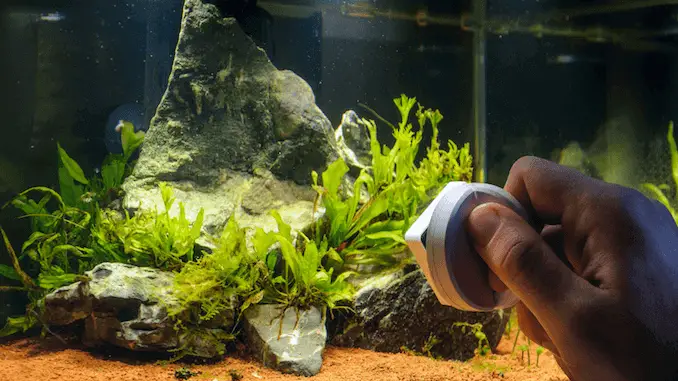
The algae outgrowth in the tank is a problem that has been encountered by almost anyone who has had an aquarium at least once. This is something that fishkeepers inevitably come across, regardless of their previous experience.
We know how important it is for your aquarium to look good, and the algae can severely harm what is inside your tank. Knowing how to get rid of algae and keeping it in check is something every beginner should learn.
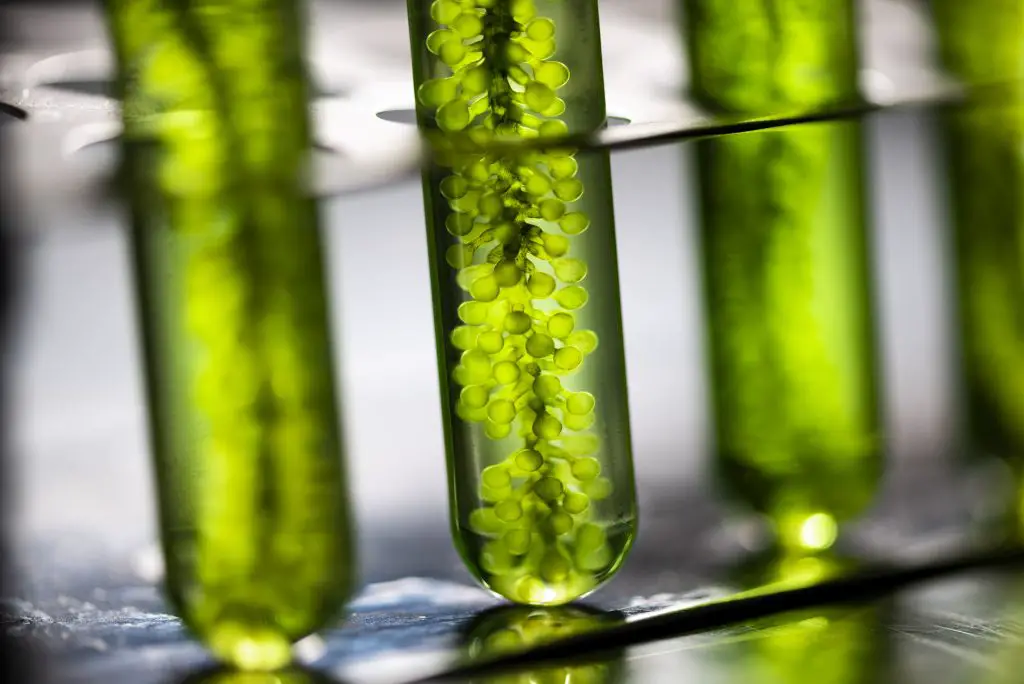
If this issue sounds familiar, join us as we take a look at this annoying problem, discuss the reasons behind it, and offer you some potential solutions. Do you think that fighting algae in your tank is complicated? Let us prove you wrong!
What is Aquarium Algae
Unlikely as it may seem at a first glance, aquarium algae aren’t actually the same thing as plants. Algae are composed of tiny living organisms that form colonies and those colonies grow to eventually make up those green mats found throughout the tank.
Although it’s common to think of green algae, which in fact is what you see most of the time, they can also be brown, black, or even blue-green. There are also various species of algae that we’re dealing with.
Now that we understand what separates algae from aquarium plants, let’s discuss how you can take care of the algae.
What You Need to Know
The variety of algae is comparable to the diversity of aquarium fish. There are plenty of them, each has its own characteristics, require different conditions to grow and may even affect your aquarium in distinct ways.
All of this once again underlines the importance of identifying what type of algae is growing in your tank. Of course, you don’t have to narrow it down to exact species, but at least know what group they belong to.
Fortunately, in most cases, you can figure out the type of algae by simply looking at them. Some grow indistinguishable patterns, while others tend to cover only specific places in the tank. Still, others cause your water to turn murky and green.
This is also what confuses most of the beginners. They see algae raging in their fish tank, densely covering up the glass, but when trying to look up solutions on community forums they can be easily misled by a person that had an issue with an entirely different algae group.
In a nutshell, to successfully put an end to rapidly growing algae you need to know the specifics, which ultimately requires you to identify what you’re dealing with.
The Usual Suspects
With such a variety of issues for a fishkeeper to encounter one thing remains the same – the simplest and yet most overlooked principles of aquarium maintenance are often typically the cause. That of biological balance.
Maintaining a balanced environment is crucial for every aspect of marine life in your tank. From breeding offspring to reducing the risk of infection. If the fragile biological balance is broken, in no time will you start seeing unwanted changes.
The algae are no exception. Most of the time aquariums are filled with smaller organisms each performing their own role, like processing waste from fish or producing nutrients. They are all limited by major factors, like lighting, food, and so on. The abundance or lack of anyone factor will lead to algae outgrowths.
Lighting
When you have set up your first tank – you’ve definitely heard it over and over again – do not place an aquarium near the window. This isn’t some aesthetic that all fishkeepers suddenly agreed upon. It is practical advice based on sound reasoning.
Although it may seem obvious to people who have some knowledge of this hobby, you would be surprised how many beginners don’t pay attention to this important aspect. For a small system, such as the aquarium teeming with life, the excessive light can be too much on the occupants. Especially if you’re using a lamp in addition.
Alternatively, it could also point you to the fact that the daylight regime in your tank isn’t exactly right. So consider either reducing or regulating the daily amount of light your aquarium gets.
It can also happen that the lamp you’re using isn’t suitable for your type of tank. This can be for several reasons, including having a setup that requires a particular daylight regime, such as a reef tank.
Waste
Keeping your aquarium clean is very important to the well-being of all its inhabitants. Taking care of any waste, both artificial and natural, should be a regular routine for any responsible fishkeeper. Unfortunately, when it is overlooked problems arise.
When aquarium filters aren’t able to handle the amount of waste that is being generated, nature starts taking over allowing algae to quickly grow. The abundance of useful nutrients in organic waste serves as a wonderful push for algae growth.
Moreover, this acts as a natural response in order to balance the system and get rid of anything that shouldn’t be there. This is why a regular cleaning routine is very important. So start making it your habit! Regularly renew the water in your tank, trim plants whenever possible, clean the equipment and the substrate.
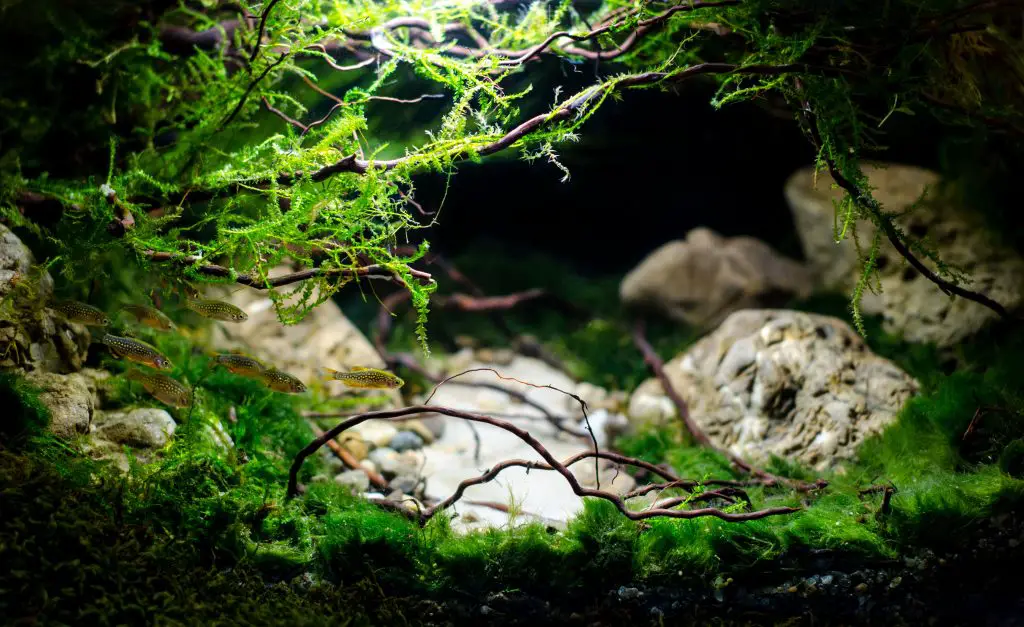
If you don’t take care of excessive waste in a timely manner, the bulk can start emitting harmful chemicals back into the water. This will not only lead to algae growth, but it can also start killing off the living occupants in your aquarium.
In that case resort to using an aquarium testing kit to understand what is wrong with the environment and get the appropriate chemicals to treat the algae.
Preventive Measures
The best treatment for anything is preventive measures. There are a few steps you can take to avoid algae blooms in your aquarium.
First, closely follow the lighting regime in the tank. Remember that algae love natural daylight. So avoid placing the tank near the window or under direct sunlight for more than 2 hours.
The same goes for any aquarium lamps. Don’t leave it working for more than 8-10 hours. This is more than enough for plants but isn’t enough for algae to start spreading – something we are looking to avoid.
The algae will overwhelm organic nutrients in the aquarium, so frequent maintenance is necessary. If you see algae starting to grow too fast, try to change about 15-30% of the tank weekly.
Alternatively, using specialized chemicals would help you get rid of nitrates and phosphates without changing the water too often. Use quality foods to facilitate the fish’s digestion, specifically include ones containing prebiotics.
Regarding the environment, as a general practice, avoid keeping the temperature warmer than the maximum recommended degrees that suit your fish. Too warm will not be a comfortable environment for any animal or plant, but algae do enjoy living in warm water.
When it comes to substrate consider using more natural materials, like river gravel, quartz sand, or artificial pebbles. They will not alter the composition of the water in your tank and will not raise the pH that is attractive for algae growth.
Excessively strong currents in the tank are not recommended. Many types of algae flourish in fast-moving environments. If your fish require a faster flow, then install a separator for your filter that would break down the flow and redistribute it more evenly.
Carefully choose your plants. The sturdier plants are often better because of their quick growth rates that don’t leave much for algae to feed on. Use fertilizers sparingly and knowingly – any excess will quickly cause algae to spread.
Look out for algae growing on your plants. If you see that happening, either get rid of the whole plant or trim the affected areas. It is important to do it soon to avoid algae from spreading throughout the tank.
You are probably familiar with a practice of adding to the tank catfish, algae, or shrimps to combat algae. They can be really effective in small tanks, but only to a point. Eventually, they will eat algae whenever they feel like it, so consistency to curb algae can be a challenge. Nevertheless, they are a good preventative measure tactic.
How to Get Rid of Algae
If none of the preventive measures have any effect then we must turn to other methods for help. From simple changes made in the tank environment to more complex treatments using aquarium medicine. So here is what you can do if you find yourself in that situation.
By far the most effective way of fighting algae outgrowths in your tank is using special chemicals called algaecides that can be found at almost any local pet store. They are also designed for use in many different environments, including home aquariums or outdoor fishponds.
You need to be careful with algaecides, not all of them are equally harmless for your aquarium inhabitants. For example, any product containing copper sulfate can be dangerous for crustaceans, like crabs or shrimps.
Your best bet is to stick to tested and well-known product lines that contain harmless chemicals. These tend to come in a variety of forms, ranging from easily dissolving tablets to sprays or drops. Some of them may even be formulated to combat specific types of algae.
The tablets can fight against rapidly growing algae and get rid of the sturdier, harder to reach growth. Whether you use tablets or liquid products, both contain chemicals designed to quickly and effectively stop the spread of any unwanted algae.
There are also products designed for long-term use. These are gradually added to the water and make it significantly harder for any type of algae to start growing as well as stop existing algae from flourishing further.
These products prevent algae from growing along the edges of plant leaves, like black algae. Those tend to be softer, noticeable only after a couple of weeks.
Finally, similar to the treatment described above, there are chemicals used solely for prophylactic purposes. This either helps purify the water and support biological balance which is usually best used in smaller tanks.
How to Use Algaecides Correctly
Now that you know what products to buy, we must give you a few notes to make sure you use them safely.
First, closely follow the manufacturer’s instructions in the included leaflet. These always provide the ratio of water volume to the amount of product that is appropriate to use in order to avoid any unwanted complications and keep your fish safe.
Second, establish good aeration for the gradual and smooth distribution of algaecides throughout the tank. Do not turn off your filters when adding any chemicals into the aquarium, always let them spread the algaecides evenly!
It is a good practice to clean your tank before starting any treatment which helps in the prevention of both algae and disease. Use a siphon to clean the gravel, clean the glass, any equipment, and check that your plants are healthy.
When using algaecides, check that you do not have a filtering cartridge with activated charcoal or UV-sterilizers. In rare cases, these items can cancel out the effects of algae treatment chemicals.

Finally, when you start seeing algae dying off, carefully remove them from the tank to avoid ruining the water quality or providing a basis for new algae blooms.
Algae Types
As we have previously mentioned, algae are not one single species, but rather include many different groups. It is important to know what you’re dealing with in order to fight them effectively. So let’s take a look at some of the most common algae types you might encounter.
Brown Algae, or Phaeophyceae
This type of algae is commonly seen growing on rocks, glass walls, gravel, or other surfaces in your aquarium. They form thin brownish mats and at later stages tend to grow closer together. Although they may look menacing, they aren’t so hard to deal with.
They often emerge in newly set up tanks which can often be attributed to the lack of biological balance in new aquariums, or a well-established nitrogen cycle. Once the environment normalizes, the brown algae will die away on its own and you would simply need to remove them.
Common Green Algae, or Chlorophyceae
The green algae include many different species but are the most common type you will encounter. They start off looking like thin threads growing from plants in your aquarium but then start to grow and spread throughout the water.
Some of the reasons behind the appearance of green algae has previously been attributed to the lack of sufficient nutrients in the aquarium. For them simply use algaecides and there shouldn’t be any issues.
Red Algae, or Rhodophyceae
This type of algae forms bushy colonies along the edges of sick aquarium plants or other places in the tank. They are very annoying and can be difficult to get rid of. Their appearance in the tank serves as a good indication of excessive organic waste in your aquarium.
Try to thoroughly clean everything. Use a siphon to clean the gravel and clean up any waste. After that filter the tank and renew the water. Then use the appropriate algaecides that will handle the job.
Diatom Algae, or Diatomeae
The diatom algae are a common problem for both experienced fishkeepers and beginners. They look like small spots on the walls of the aquarium that’s really hard to scrub off. They often appear because of incorrect lighting conditions, like overly long daylight regimes in smaller tanks.
Regulate your lighting regime, use algaecides, clean the tank, or get yourself a pair of catfish that would gladly feed on them. Frequent water renewals are also really beneficial.
Bluegreen Algae, or Cyanophycean
This alga is relatively rare, but you should be aware of them, nevertheless. They often grow along the base of plants or on the very top of decorations. The Bluegreen algae are also quite toxic, so you need to take care of them as fast as possible.
Bluegreen algae are bacterial colonies and can be fought off using specialized aquarium chemicals. Simply look for them at your local pet store.
Summary
Now you know more about algae and how they are an unpleasant but yet solvable problem. The only thing it takes to get rid of them effectively is knowing what type you’re dealing with, understanding the potential causes, and what products to use.
Keep in mind that the most efficient way of dealing with algae blooms in your aquarium will be to implement preventive measures. Following our tips for supporting a healthy environment and keeping your tank clean can stop any algae from ever finding their way into your aquarium.
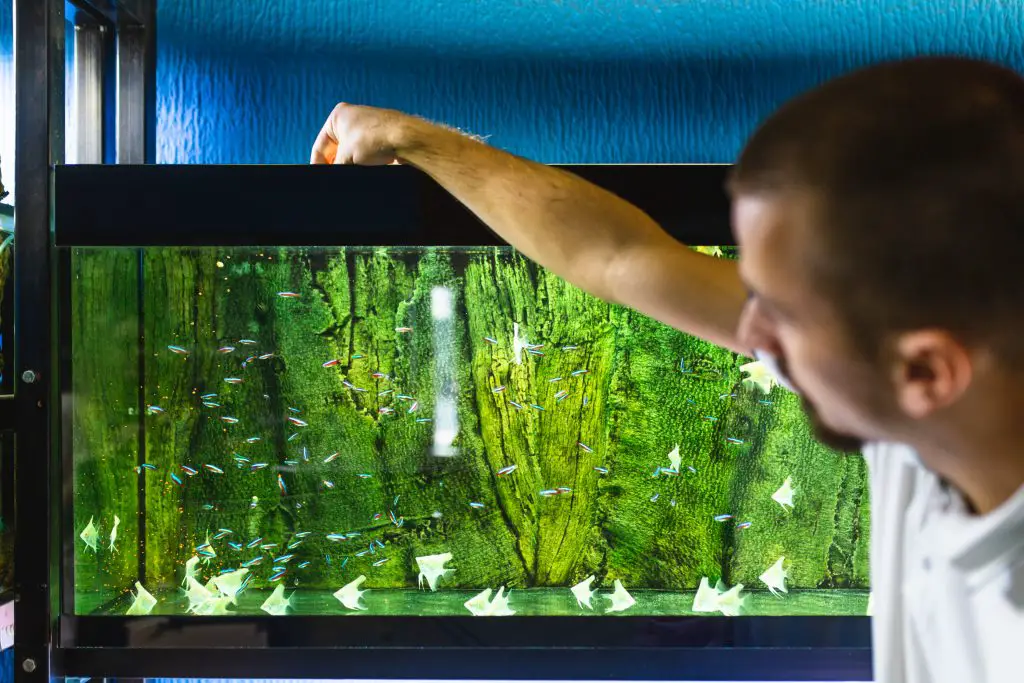
With all of our advice on hand, you surely won’t have any issues with those little saboteurs in the future!
Have you ever had algae bloom in your tank? How do you usually get rid of it? Let us know in the comments section below…

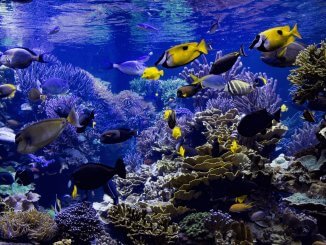
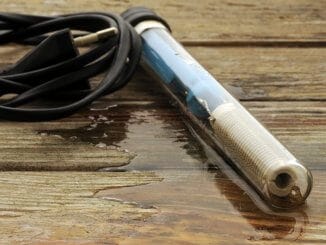

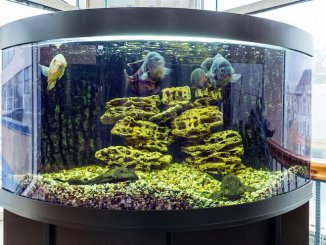
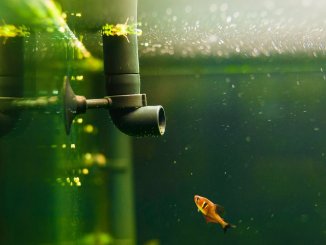
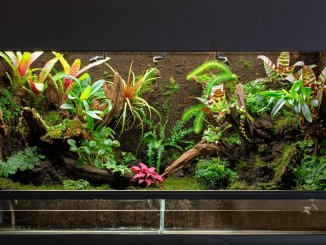
Be the first to comment